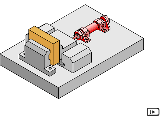[169] Exercise: Clamping device (closing speed)
 Workpieces are clamped by a
hydraulic cylinder. The closing speed must be reduced in order to
prevent damage to the workpieces. The opening speed must,
however, be maintained. The question here is how to incorporate
the necessary one-way flow control valve in the circuit. Possible
solutions must be examined to see what thermal side- effects
occur and to determine the pressure load placed on the components
concerned.
Workpieces are clamped by a
hydraulic cylinder. The closing speed must be reduced in order to
prevent damage to the workpieces. The opening speed must,
however, be maintained. The question here is how to incorporate
the necessary one-way flow control valve in the circuit. Possible
solutions must be examined to see what thermal side- effects
occur and to determine the pressure load placed on the components
concerned.
The advance stroke can as a general principle be made slower by using either inlet or outlet flow control. Either solution can be used in this control; in comparison with outlet flow control, inlet flow control has the advantage that no pressure intensification will take place. The oil heated at the throttle point will, however, then pass through the power component. The resulting expansion of material is not, however, of significance for this simple vice. If the solution with outlet flow control is selected, it should be borne in mind that pressure intensification will take place in accordance with the area ratio of the differential cylinder of 2:1. The pressure relief valve will respond, i.e. flow division will occur, only when a pressure has built up on the piston-rod side which is approximately twice as high as the system pressure set on the PRV. The cylinder, flow control valve and connectors used must therefore be suitable for this intensified pressure.
Precision drives for machine tools are a good example of cases in which it is essential to make allowance for expansion of the material of power components due to the passage through these of heated oil.

